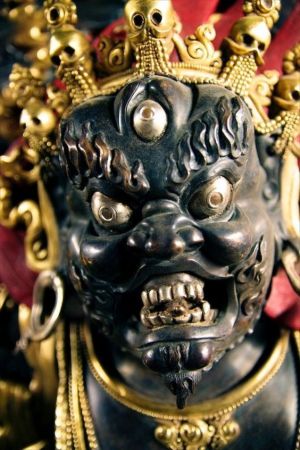CHÖD TRANSMISSIONS AND LINEAGES
In this chapter, I will be examining various textual sources that provide indications of the
lineages of Buddhist Chöd teachings. There are contradictory and diverse transmission lineages
presented in the various emic sources that we have on the Chöd tradition, suggesting conflicting ideas about the development of the tradition and authority.47 Understanding transmissions of Chöd teachings is particularly difficult because they represent two different means of authenticating the tradition. Transmission lineages record the actual passing on of teachings, thus representing the renewal of the tradition, but they also retrospectively associate Chöd teachings with precursor figures, thus legitimating Chöd through its association with existing traditions.
As with Machik Labdrön’s development of teachings that were both innovative and traditional, the lineage histories of Chöd both reinterpret and affirm the existing tradition. As a corrective to the prevailing image of Chöd as an ahistorical and uniform system, the critical comparison of transmission sources can help to build a complex picture of this development and legitimation of Chöd traditions.
Chöd lineages have been examined by other scholars, most extensively by Karénina Kollmar-Paulenz (1993; 227ff).48 As is made evident by Kollmar-Paulenz’s schematics diagramming the transmissions of Chöd according to the various source texts she surveys, there are a variety of opinions about the transmission history of this tradition.49 While several lineages 47 “The classification of all of the transmissions and teachings of Machik’s Chöd is extremely confusing and
conflicting, and it is not the subject of this introduction. See Edou (1996), Kollmar-Paulenz (1993) and (1998), Gyatso (1985), and Orofino (1987)” (Harding 2003, 292, n. 59). 48 One source that Kollmar-Paulenz did not consider is the Man ngag zab mo bdud kyi gcod yul stan thog gcig ma’i
gzhung by Rje smon lam Mtha’ yas rgya mtsho, a Gelukpa scholar who was born in 1863. This text is in the Gcod tshogs: The Collected Gcod Teachings of the Dge-lugs-pa Tradition (Dharamsala: LTWA, 1986, 291-43). I have
completed a translation of this text and will be presenting it in a future study. 49 Others have presented similar lists, although none as comprehensively as Kollmar-Paulenz 1993. For comparison, see Gyatso (1985), Orofino (1987). Edou (1996), Machik Labdrön and Harding (2003), Zong Rinpoche and Molk
of Chöd have been traced, these lineages have not been considered in terms of their historical
contexts, with attention to the tradition(s) of the author(s) and the period of composition. In
order to understand both how Chöd legitimated itself as a tradition and how it was regenerated,
these lineages must be analyzed in terms of dates of transmissions (if they can be gleaned),
identities of recipients, and doxological considerations.
Although much more work needs to be done to complete a comprehensive analysis of Chöd sources, this chapter will outline some of the important historical developments and different tangents in the lineage transmissions of Chöd. In general, although there is agreement that Chöd has been adopted by various Tibetan schools, many scholars represent Chöd as a unitary and unified tradition, without concern for how, when and to whom Chöd was transmitted, nor for the temporal and practical differences between the transmissions. The role of interpretation in the transmission of Chöd has thereby been obscured.50 In this chapter, I consider a range of presentations of transmission lineages in terms of chronology and
institutional affiliations. These documents help us to identify key figures and to trace lineages and traditions in the development and transmission of Buddhism in Tibet. This survey will help to undergird further analyses of the “movement” of Chöd and the stakes for legitimation of the tradition. Ultimately, this study will pave the way for future analysis of shifts in doxa and praxis depending on the author and his institutional affiliations during the period of composition. I begin here with a brief overview of precursor texts and Chöd transmission lineages. Next, I survey a number of chos ‘byung (Dharma histories) and rnam thar (spiritual biographies)
(2006), and Lodö Rinpoche (2007).
50 In a later section of this study, I will consider a particular case of interpretation involving the Bka’ tshoms chen
mo, attributed to Machik Labdrön, and the earliest extant commentary on this teaching by the Third Karmapa
Rangjung Dorjé, approximately two hundred years later.
to outline key issues in legitimating and renewing the tradition.51 I then examine three texts
central to considering Chöd lineages: The Great Explanation rnam thar, which appears to be the
earliest extant text (ca. 14th century with possible inclusion of earlier elements) discussing
transmission lineages of Chöd; The Blue Annals, a highly-regarded 15th-century chos ‘byung text
discussing a wide range of figures and teachings, including Machik Labdrön and Chöd
transmissions; and the lineage list contained in another 15th-century text, the Ring brgyud gsol ‘debs, which is important to my project since it explicitly contextualizes the Third Karmapa Rangjung Dorjé within a Chöd transmission lineage. These texts chart key developments in the transmission of Chöd teachings. The chapter concludes with my own provisional genealogy of key figures in the development of Chöd up to Rangjung Dorjé.
Source
[[1]]
